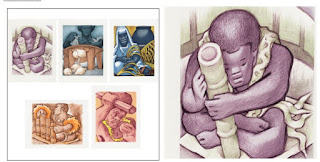Jean Charlot
Kei Viti 1978
Colección de Arte Cantú Y de Teresa
JEAN
CHARLOT
(París, Francia, 1898 - Hawái, EE.UU., 1979)
Kei Viti melanesian images, 1976
French-born muralist, painter,
and book illustrator who was known for monumental frescoes that show the
influence of Mayan art.
Living off the beaten track, Naiserelagi’s settlers are Melanesians,
direct descendants of the pioneers who, over a millennium ago, beached theirs canoes on these islands. Theirs a mysterious
race, muscular black bodies shaped for jungle forays, their gestures softened
by an ancestral code of politeness.
Subjects and sights that failed to become parte of fresco mural remained
perforce dormant, but far from forgotten. Now after fifteen years, some of them
acquire shape and color in these five lithographs.
The title of the portfolio Kei Viti , may puzzle the onlooker. I chose
it however because it alone ties together the lay of the land with what
aboriginal traditions still make a visit to Fiji a unique esthetic experience.
Jean Charlot
En Naiserelagi Fiji. Hay una misión de la iglesia dedicada
a San Pedro Chanel, martirizado en la pequeña isla de la fortuna.
En 1962, su pastor Mons. Franz Wasner me invitó a
decorado sus paredes interiores con la técnica del fresco.
Vivir fuera de los caminos, los colonos de Naiserelagi
que son melanesios, descendientes directos de los pioneros que hace más de un
milenio se establecieron llegando en canoas ah estas islas.
Esta raza misteriosa de cuerpos negros musculosos que
habitan la selva, con sus gestos suavizados por un código ancestral de
cortesía.
Los sujetos y lugares que no lograron convertirse en
parte del mural al fresco permanecieron forzosamente latentes en mi recuerdo,
pero muy lejos de ser olvidados.
Ahora, después de
quince años, algunos de ellos adquieren forma y el color en estos cinco litografías.
El título del portafolio Kei Viti, puede desconcertar al
espectador. Lo elegí sin embargo porque sólo ella une la disposición de la
tierra, con lo que las tradiciones aborígenes todavía hacen recordar la visita
a Fiji que siempre será para mi una
experiencia estética única.
Jean Charlot
Kei Viti 1978
Colección de Arte Cantú Y de Teresa
e) Tagane Dauravuravu: ancient warrior
JEAN CHARLOT Kei
Viti melanesian images
Charlot, whose mother was of
Mexican descent, moved to Mexico City in 1920. There he painted frescoes for the Mexican government
with artists such as Diego Rivera and José Clemente Orozco. From 1926 to 1929 Charlot was the staff artist for a
Carnegie Institute archaeological expedition in the Yucatán. Moving to the United States in 1929, he taught at many schools—including the Art
Students League in New York City
The contemporary (in 1930)
painters included in this exhibition were Abraham Angel, Abelardo Avilar, Federico
Cantú, Pablo Camareno, Julio Castellanos, Jean Charlot, Joaquin Clausell,
Dosamantes, Maria Izquierdo, Agustin Lazo, Manuel Rodriguez Lozano, Ignacio
Marquez, Carlos Merida, Pablo O’Higgins, Carlos Orozco-Romero, Maximo Pacheco,
Everardo Ramirez, Fermin Revueltas, Miguel Covarrubias, Rufino Tamayo, Jose
Clemente Orozco, Diego Rivera, Roberto Montenegro and David Alfaro Siqueiros.
Lynton Richard Kistler was born August 30, 1897 in Los Angeles CA.
From Los Angeles Times: Obituaries - Lynton
R. Kistler; Modern Artists' Lithographer
Lynton R. Kistler, a pioneering California
lithographer who printed the work of 20th-Century artists from Jean Charlot to Millard
Sheets and Wayne Thiebaud, has died. He was 96. Kistler died at his home in
Laguna Hills Nov. 9, Tobey Moss of the Tobey Moss Gallery said Monday.
A native of Los Angeles, Kistler attended
Hollywood and Manual Arts high schools and served in the Army during World War
I. He began his career in his father's letterpress printing shop and quickly
gravitated to the new offset lithography, a printing process using grease and
water on flat stones and, later, on metal plates.
Kistler met Charlot, Edward Weston and other
artists through a friend, Merle Armitage, who was a modern art collector and
manager of the Los Angeles Grand Opera Company. Soon Kistler became known as
the best stone lithographer in the country. Other artists whose work Kistler
printed included Lorser Feitelson, Helen Lundeberg, Beatrice Wood, Hans
Burkhardt, Eugene Berman, Clinton Adams, Palmer Schoppe and Joe Mugnaini. He
also printed work by June Wayne,
and inspired her in 1960 to open her Tamarind Lithography Workshop, now at the
University of New Mexico.
In 1981, the Heritage Gallery exhibited 70
works by various artists printed by Kistler. At the time, he modestly told
Times art critic William Wilson that the work had no particular Kistler touch.
But, he said, he took pride in printing as the artists wanted and in technical
expertise. Kistler taught lithography at UCLA Extension and, in 1950, published
the book "How to Make a Lithograph." A collection of his lithographs
and one of his earliest presses are in the Smithsonian Institution.










No hay comentarios:
Publicar un comentario